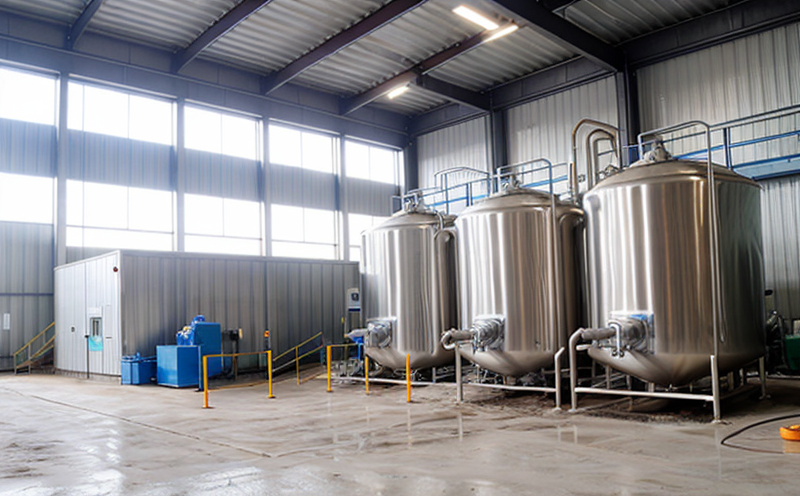ASTM D5464 Bacterial Growth Potential Test in Process Water
The ASTM D5464 test method is a critical tool used to assess bacterial growth potential (BGP) in industrial process water. This test evaluates the presence of viable bacteria that could potentially lead to biofilm formation, corrosion, and fouling within water systems. Such issues can significantly impact the efficiency and longevity of industrial processes, necessitating regular monitoring and intervention.
The BGP test is particularly relevant for industries with high microbial activity, such as pulp and paper manufacturing, textiles, power generation, and food & beverage processing. By identifying bacteria capable of rapid multiplication under specific conditions, this test helps quality managers make informed decisions to maintain water quality and process efficiency.
During the ASTM D5464 test, a sample is incubated in nutrient broth with various metals like iron and manganese present at concentrations typically found in industrial waters. The presence of these elements can stimulate bacterial growth, making this an effective method for assessing potential biofilm formation. Following incubation, any visible turbidity or color change indicates the presence of viable bacteria.
Understanding the BGP is essential for process optimization. For example, in the pulp and paper industry, minimizing bacterial growth helps prevent the degradation of fibers and ensures consistent product quality. In power generation plants, reducing biofilm formation can enhance heat transfer efficiency and extend equipment lifespan. The food & beverage sector benefits from this test by ensuring hygiene standards are met throughout the supply chain.
The ASTM D5464 method is widely accepted in industry standards, providing a robust framework for evaluating bacterial growth potential. This ensures consistency across different facilities and supports regulatory compliance. Compliance officers can rely on this test to meet environmental protection regulations without compromising operational efficiency.
Applied Standards
The ASTM D5464 standard specifies the procedure for determining the bacterial growth potential of process water by incubating samples in nutrient broth containing iron and manganese. This method is particularly useful for assessing microbial activity under conditions similar to those found in industrial systems.
- Sample Collection: Samples should be collected from points where there is a risk of biofilm formation, such as heat exchangers or cooling towers.
- Incubation: Incubate the samples at 25°C ± 1°C for 7 days to allow sufficient time for bacterial growth if present.
- Analysis: After incubation, visually inspect the samples for any changes in turbidity or color. Record these observations as evidence of potential biofilm formation.
The standard also recommends that laboratories have proficiency testing programs to ensure consistent and accurate results across different facilities.
Customer Impact and Satisfaction
- Improved Product Quality: By identifying potential bacterial growth early, industrial processes can maintain consistent quality levels. This is crucial for industries like food & beverage where product safety is paramount.
- Economic Benefits: Preventing biofilm formation reduces maintenance costs and extends the life of equipment. This translates to significant long-term savings for businesses operating complex water systems.
- Regulatory Compliance: Meeting stringent microbial limits in process waters ensures that companies comply with environmental regulations, thereby avoiding penalties and negative publicity.
In terms of customer satisfaction, the ASTM D5464 test offers a proactive approach to water quality management. By providing actionable insights into bacterial growth potential, it enables industries to implement targeted interventions before issues escalate. This not only enhances operational efficiency but also builds trust with stakeholders who rely on consistent product performance.
Quality managers and compliance officers can rest assured that this testing method provides reliable data that supports decision-making processes. The detailed reports generated from the ASTM D5464 test allow for targeted improvements in water treatment strategies, leading to enhanced process reliability and customer satisfaction.
Competitive Advantage and Market Impact
- Innovation Leadership: Companies that leverage the ASTM D5464 test method can stay ahead of competitors by continuously improving their water treatment processes. This innovation strengthens their position in competitive markets.
- Sustainability Focus: By minimizing biofilm formation and reducing waste, businesses demonstrate a commitment to sustainability. This aligns with growing consumer demand for eco-friendly products and services.
- Premium Brand Image: Demonstrating advanced water management practices through the use of ASTM D5464 can enhance brand reputation among environmentally conscious customers.
The market impact of using this testing method is significant. Industries that prioritize microbial control not only benefit from reduced operational costs but also contribute to a healthier environment by minimizing pollution risks associated with biofilm formation. This approach fosters trust and loyalty among consumers, ultimately driving market share growth.
For R&D engineers, the ASTM D5464 test offers valuable data for refining water treatment technologies. By understanding bacterial growth potential under various conditions, they can develop more effective solutions tailored to specific industrial needs. This collaborative effort between quality management teams and R&D departments ensures continuous improvement in process efficiency.





